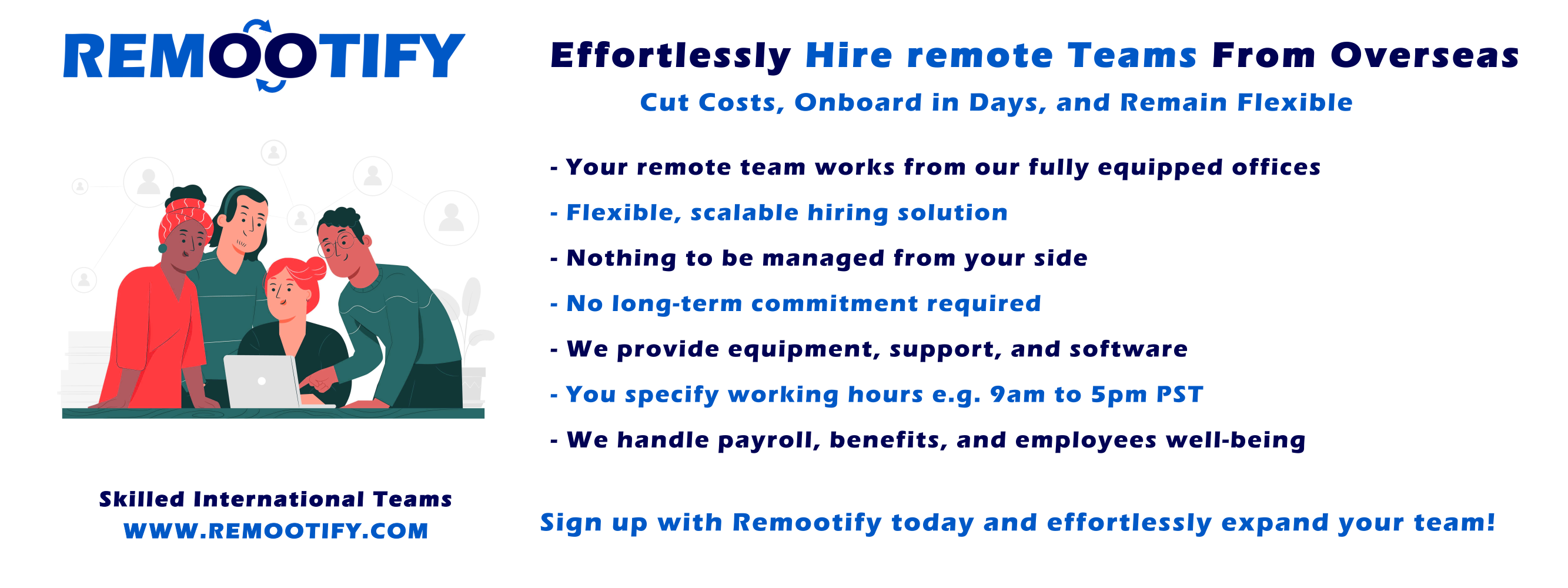Start hiring YOUR REMOTE TEAM, Today!
Enter your information below to start a discussion with one of our team members!

In our swiftly evolving technological landscape, the definition of work is being redefined. Remote work, once a novelty, has become a cornerstone of modern employment, driven by technological advancements and changing work dynamics.
This article delves into emerging remote work trends, uncovering their transformative impact on industries, human interaction, and the fundamental concept of work.
The State of Remote Work Before and After the COVID-19 Pandemic
The State of Remote Work Before the COVID-19 Pandemic
Before the COVID-19 pandemic, remote work was already a growing trend in many industries, driven by advancements in technology and changes in workplace culture.
However, it was not as widespread or deeply integrated into businesses as it became during and after the pandemic.
Limited Adoption
- Remote work was not the norm; most jobs required physical presence.
- Few industries embraced remote work fully.
Tech-Centric Roles
- Common in tech, freelance, and creative sectors.
- Digital communication made remote work feasible.
Flexible Arrangements
- Some companies allowed occasional remote work.
- Flexibility was not extended to all employees.
Communication Tools
- Relied on basic tools: email, IM, video calls.
- Tools were less integrated than today’s solutions.
Productivity Concerns
- Employers were worried about remote work’s impact on productivity.
- Direct supervision was seen as essential for quality control.
Remote Work Challenges
- Employees faced isolation and communication issues.
- Work-life balance and boundaries were challenging.
Limited Remote Work Policies
- Companies with remote work policies had specific guidelines.
- Not all organizations offered remote work options.
On-Site Collaboration
- In-person interactions were valued for teamwork and creativity.
- Face-to-face meetings were preferred for certain tasks.
Focus on Infrastructure
- High-speed internet and proper home offices were crucial.
- Limited setups could hinder remote work success.
Geographic Constraints
- Remote work was mainly feasible for computer-based roles.
- Jobs requiring physical presence couldn’t go remote.
Job Categories
- Remote work was common in virtual roles, less in hands-on jobs.
- Customer-facing and physical tasks stayed on-site.
The State of Remote Work After the COVID-19 Pandemic
The COVID-19 pandemic acted as a catalyst that propelled remote work from a niche practice to a mainstream work arrangement.
Many of the changes and adaptations that were initially adopted out of necessity have continued to shape the way businesses and individuals approach work, resulting in a more flexible and digitally connected work environment.
Widespread Adoption
- Remote work became common across industries.
- Many companies shifted to remote or hybrid models.
Remote-First Approach
- Some companies adopted permanent remote work structures.
- Remote work is considered a viable long-term option.
Advanced Collaboration Tools
- Extensive use of integrated communication and project management tools.
- Video conferencing and virtual collaboration became seamless.
Shift in Productivity Perception
- Remote work’s potential for productivity is recognized.
- Output is measured by results, rather than hours worked.
Flexible Locations
- Work from anywhere (WFA) policies emerged.
- Employees had greater freedom to choose their location.
Redefining Company Culture
- Emphasis on maintaining virtual company culture.
- Virtual team-building activities and online social interactions.
Hybrid Models
- Many companies adopted hybrid work models.
- Blend of remote and in-office work for flexibility.
Upskilling and Reskilling
- Demand for digital skills increased.
- Employees focused on tech literacy and virtual collaboration.
Impact on Commercial Real Estate
- Some companies downsized physical office spaces.
- Reduced need for extensive office infrastructure.
Global Talent Pool
- Hiring from anywhere expanded talent options.
- Diversity and inclusion improved in some cases.
Legislative and Legal Implications
- Remote work across state/country borders led to legal considerations.
- New regulations for remote work taxation and employment emerged.
Redefining Leadership
- Leadership skills evolved to manage remote teams.
- Trust-based management gained prominence.
Environmental Impact
- Reduced commuting led to lower carbon emissions.
- Sustainable practices integrated into remote work.
Rise of Digital Nomadism
- Remote work enabled digital nomad lifestyle.
- Some professionals embraced location-independent work.
Advantages of Remote Work
| Benefits of Remote Work | Description |
|---|---|
| Flexibility | Choose work hours for better work-life balance. |
| Increased Productivity | Reduced distractions can boost task efficiency. |
| Cost Savings | Less commuting expense and lower office costs. |
| Global Talent Access | Hire diverse talents and skilled employees worldwide. |
| Autonomy & Ownership | Employees have more control and responsibility. |
| Business Continuity | Operations continue during crises and disruptions. |
| Improved Job Satisfaction | Freedom and trust lead to happier employees. |
Emerging Trends in Remote Work
A. Hybrid Work Models: Combining Remote and In-Office Work
- One of the prominent remote work trends is the adoption of hybrid work models, which involve a strategic balance between remote and in-office work.
- Organizations are recognizing the benefits of allowing employees to embrace both remote work and in-person collaboration, reflecting the changing nature of work preferences.
- This approach to remote work trends offers employees the flexibility to divide their work time between remote and in-office settings, based on their tasks and personal choices.
- Hybrid work models also prompt a reconsideration of office spaces, focusing on creating dynamic environments that foster collaboration rather than merely housing employees on a daily basis.
B. Emphasis on Asynchronous Communication
- Asynchronous communication has emerged as a vital aspect of modern remote work trends, shifting the traditional real-time communication paradigm.
- In this remote work trend, teams prioritize communication methods that don’t require immediate responses, allowing for better synchronization across different time zones and schedules.
- This approach to remote work trends not only enhances productivity but also supports employees in achieving a healthier work-life balance, reducing the pressure to be constantly available.
C. Virtual Reality and Augmented Reality in Remote Collaboration
- Among the cutting-edge remote work trends is the integration of virtual reality (VR) and augmented reality (AR) technologies into remote collaboration strategies.
- This remote work trend involves creating immersive virtual meeting spaces and shared work environments that provide a sense of presence, despite physical distances.
- VR and AR are revolutionizing training programs, design collaborations, and team interactions, providing visual and interactive experiences that transcend traditional communication tools.
D. Results-Oriented Performance Evaluation
- A notable shift in remote work trends is the transition towards results-oriented performance evaluation.
- Rather than focusing solely on hours worked, this remote work trend emphasizes evaluating employees based on their achieved outcomes.
- This approach not only fosters a sense of accountability and autonomy among remote workers but also aligns with the nature of remote work, where the emphasis is on productivity regardless of physical presence.
E. AI-Driven Productivity Tools for Remote Workers
- AI-driven productivity tools are at the forefront of modern remote work trends, providing innovative solutions for remote workers to excel in their roles.
- These tools, driven by artificial intelligence, assist remote workers with various tasks such as scheduling, data analysis, and streamlined communication.
- By integrating virtual assistants and data-driven insights, this remote work trend empowers workers to optimize their performance and time management in increasingly dynamic work environments.
These remote work trends collectively highlight the dynamic shifts occurring in the way we approach work, leveraging technology and new strategies to adapt to the evolving landscape of remote work.
Strategies for Thriving in Remote Work Environments
A. Developing Strong Remote Communication Skills
- Effective communication remains a cornerstone of success in remote work environments.
- Mastering written communication for clear and concise remote interactions.
- Polishing video conferencing etiquette, including active listening and non-verbal cues.
- Embracing asynchronous communication methods to accommodate different schedules.
B. Nurturing a Sense of Belonging and Company Culture
- Despite the physical distance, fostering a sense of belonging contributes to a positive remote work experience.
- Participating in virtual team-building activities and online social events.
- Actively engaging in company-wide discussions and initiatives to stay connected.
- Sharing personal experiences and anecdotes to humanize remote interactions.
C. Setting Boundaries Between Work and Personal Life
- Maintaining a healthy work-life balance is crucial in remote work environments.
- Establishing a dedicated workspace that minimizes distractions.
- Defining clear start and end times for work to prevent overworking.
- Communicating boundaries to colleagues and family members to ensure uninterrupted focus.
D. Leveraging Emerging Technologies for Personal and Team Productivity
- Embracing technological advancements can enhance both individual and team productivity.
- Exploring AI-driven productivity tools for efficient task management.
- Utilizing project management software to streamline collaboration and track progress.
- Incorporating virtual reality or augmented reality for immersive teamwork and training.
—
Conclusion
In a swiftly changing work landscape, remote work trends have evolved significantly. From pre-COVID limitations to post-pandemic hybrid models, asynchronous communication, and advanced tech integration, these remote work trends redefine how we thrive.
Success now hinges on adaptable communication, boundary management, and harnessing technology. This shift points toward a boundary-free work future fueled by innovation and collaboration.
—
FAQs
What are remote work trends and why are they important?
Remote work trends encompass the evolving patterns and practices of remote employment. They are important as they reflect the changing nature of work, driven by technology and shifting work dynamics, offering insights into how industries and individuals adapt to new ways of working.
How has remote work changed post-COVID-19?
The pandemic accelerated remote work trends, shifting from niche to mainstream adoption, including hybrid models, asynchronous communication, and advanced tech integration.
How do virtual reality (VR) and augmented reality (AR) shape remote work trends?
VR and AR enhance remote collaboration, creating immersive experiences for training, design, and team interactions.
What’s the role of AI-driven tools in remote work trends?
AI-driven tools enhance remote work efficiency by aiding task management, data analysis, and communication.





